I’m always looking for ways to cut down on my monthly expenses, and one of the areas I’ve been having a problem controlling is electricity consumption. The issue is that we don’t really know what’s keeping our bill so high, making it difficult to affect changes. There are energy monitoring devices available, but most of them have some sort of contraption that connects to the utility meter and then transmits usage to a reader inside the home. Efergy has what I believe is a more practical solution with their Engage Wireless Energy Monitor. It reads the actual current flowing through mains at the breaker box in the house and calculates the power consumed. I installed the unit in less than 15 minutes and now can see my electricity usage real-time.
Efergy offer several devices and accessories for power monitoring. What I received was the elite engage hub system which consists of an elite classic energy monitor and the accessory hub that allows you to monitor your energy usage online. The monitor is listed at $99 and the monitor plus the hub is $144.95.
elite classic features
- Shows per hour calculations for a better understanding and feedback
- Select up to 4 different tariff settings
- Audio alert if you exceed your set maximum consumption target
- Peak time symbol when the most expensive tariff is in use
- Humidity and temperature functions added
- Easy to read, portable compact display, can be placed anywhere in the home
- View your real time energy consumption (cost, CO2 and kWh)
- View historical daily, weekly or monthly data (cost, CO2 and kWh)
- View daily, weekly or monthly average (cost, CO2 and kWh)
- Up to 328ft (70 m) range
- Portable or wall-mountable display
- 12 months minimum battery life (with 2400 mAh alkaline batteries)
- Mains or battery powered options for the display unit
engage online platform features
- Access your energy data anytime, from anywhere
- See your energy data on our FREE platform and apps for Android and iPhone
- Eliminate bill shock, monitor your energy costs in real-time
- View your daily, weekly, monthly or average costs in easy-to-read graphics
- Download your energy data into an Excel sheet
- Set your monthly budget and see how close you are to meeting it
- Compare your energy over 12 months and see where your costs are highest
- Choose to view your energy data in $, kWh or CO2
- Discover and reduce your carbon footprint
- Teach your family about energy use and saving
- Use the engage elite kit to track reductions in your household energy
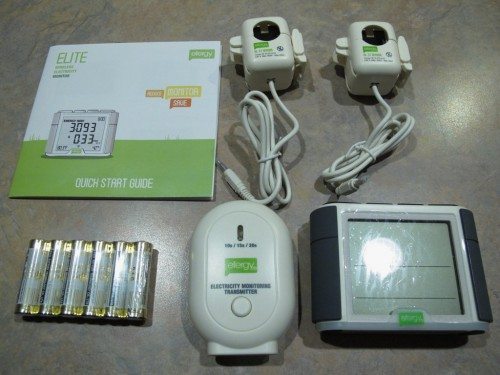 These are the components of the classic monitoring system.
These are the components of the classic monitoring system.
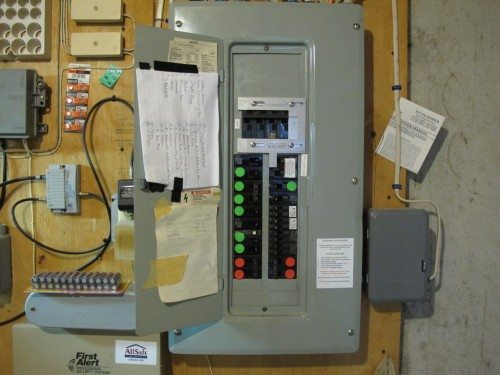 To install the energy monitor you’ll need access to the breaker panel. For me this was easy because the panel is in the basement and all sides are easily accessible. If your panel is mounted in a way where there’s wall board abutted to it, you may need to poke some holes in the wall board to run the wires. Also, you may not be able to use this device if you live in an apartment where access to the breaker panel is restricted. Might want to check with the landlord first.
To install the energy monitor you’ll need access to the breaker panel. For me this was easy because the panel is in the basement and all sides are easily accessible. If your panel is mounted in a way where there’s wall board abutted to it, you may need to poke some holes in the wall board to run the wires. Also, you may not be able to use this device if you live in an apartment where access to the breaker panel is restricted. Might want to check with the landlord first.
 Here’s my electrical panel with the cover removed. HEADS UP! Read the next sentence carefully! If you are uncomfortable working around high voltages or it is illegal in your area for a non-licensed electrician to work within the electrical panel, please hire someone qualified to install the monitor sensors. At one point in my life I was an electrician, so I felt comfortable clamping the sensors to the 220 volts mains.
Here’s my electrical panel with the cover removed. HEADS UP! Read the next sentence carefully! If you are uncomfortable working around high voltages or it is illegal in your area for a non-licensed electrician to work within the electrical panel, please hire someone qualified to install the monitor sensors. At one point in my life I was an electrician, so I felt comfortable clamping the sensors to the 220 volts mains.
 The sensors clamp around the incoming mains wires from the meter. There is no modification required to the wires. Be careful. The voltage across the two terminals with the brass screws is 220 volts!
The sensors clamp around the incoming mains wires from the meter. There is no modification required to the wires. Be careful. The voltage across the two terminals with the brass screws is 220 volts!
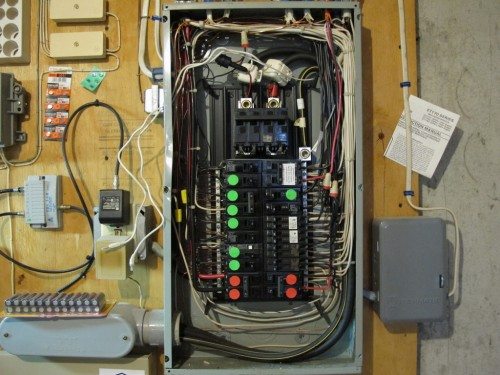 Here you can see the sensors with their wires run through a punch-out in the panel.
Here you can see the sensors with their wires run through a punch-out in the panel.
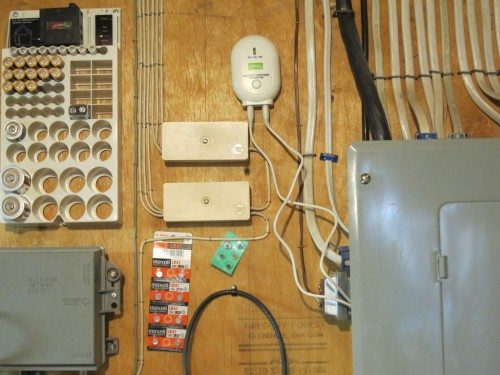 The next step is to connect the sensor wires to the transmitter after having installed the batteries.
The next step is to connect the sensor wires to the transmitter after having installed the batteries.
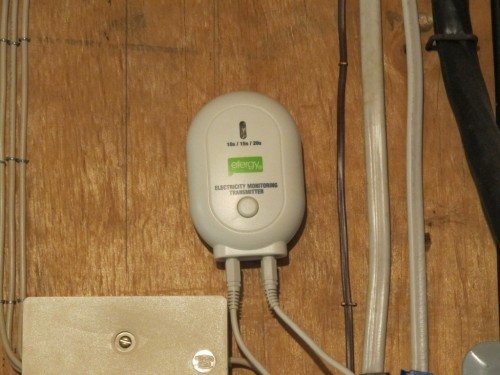 A closer look at the transmitter. It is set up to send data to the monitor display every 10 seconds, but this can be changed to a longer period if you wish.
A closer look at the transmitter. It is set up to send data to the monitor display every 10 seconds, but this can be changed to a longer period if you wish.
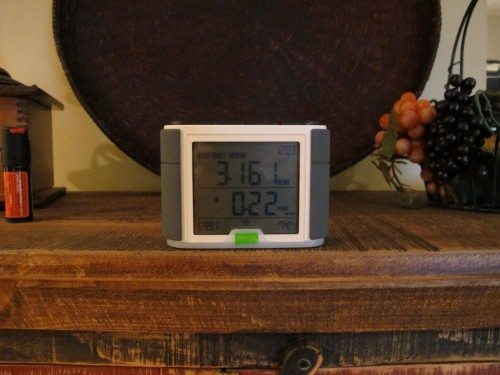 The final step to begin monitoring your electricity usage is to put batteries in the display and wirelessly link it to the transmitter.
The final step to begin monitoring your electricity usage is to put batteries in the display and wirelessly link it to the transmitter.
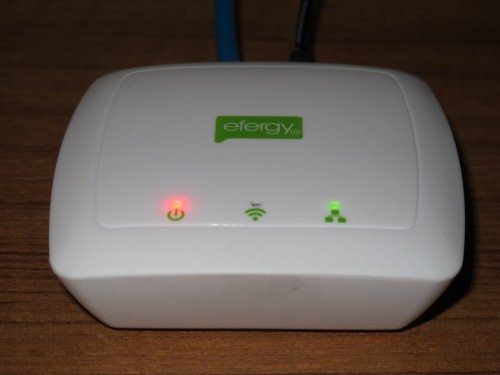 Because I received the hub kit, I had several other steps to take to finish my installation. After connecting the hub to my LAN, I then created a free account at the efergy website and also downloaded an app for my iPod and iPad. I could now monitor usage and plot trends using the apps and a web browser on my PC.
Because I received the hub kit, I had several other steps to take to finish my installation. After connecting the hub to my LAN, I then created a free account at the efergy website and also downloaded an app for my iPod and iPad. I could now monitor usage and plot trends using the apps and a web browser on my PC.
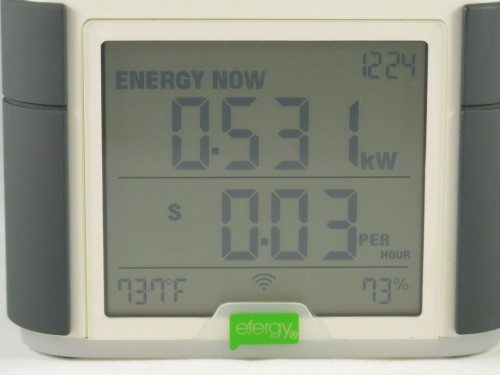 I’ve found that the data provided by the meter is more than enough. You can set your per kilowatt-hour rates in the meter and you’ll then get an approximation of how much you’re spending per hour in real-time.
I’ve found that the data provided by the meter is more than enough. You can set your per kilowatt-hour rates in the meter and you’ll then get an approximation of how much you’re spending per hour in real-time.
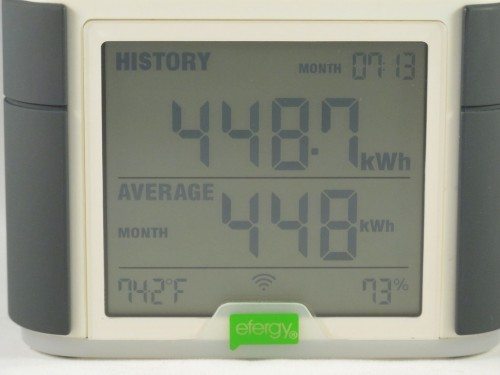 There is also provision for looking at historical data for week and month usage.
There is also provision for looking at historical data for week and month usage.
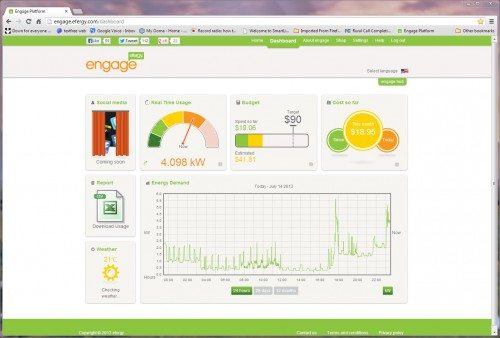 For those who opt for the hub accessory, you can really get into data collection and analysis. From the browser app you can see consumption graphically and download the data to crunch using a spreadsheet.
For those who opt for the hub accessory, you can really get into data collection and analysis. From the browser app you can see consumption graphically and download the data to crunch using a spreadsheet.
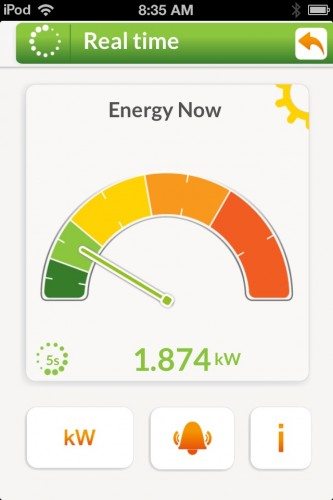 On your iPhone/Android phone there is less information.
On your iPhone/Android phone there is less information.
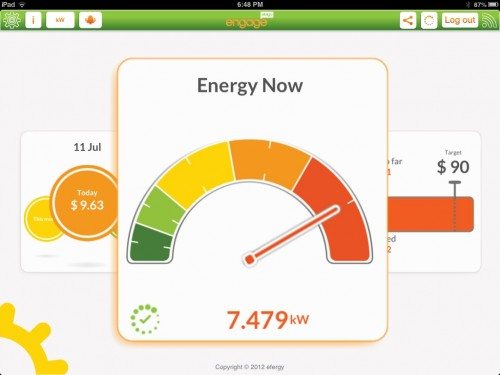 And if you have an iPad, the display is similar to that available on the desktop.
And if you have an iPad, the display is similar to that available on the desktop.
There are a couple of things to bear in mind when considering this device: The power consumption is approximate. It does not take into account voltage fluctuations or power factor, so it isn’t meant for use to challenge your electric bill. Efergy has a True Power Monitor that you can purchase, but for my purposes it’s not necessary. Most importantly, it does not control your electric usage. That’s completely up to you. It does provide you with information so that you can change your power using habits.
I’ve found the engage wireless energy monitor a fantastic teaching device. There are certain people in my household who now understand the consequences of leaving the oven on for 10 minutes AFTER the pizza has been removed. We’ve also learned what it costs to leave the lights on when it’s not necessary and the cost of all the charging devices we have plugged in. I really am surprised at the change I’ve seen in attitude after I demonstrate the cost of their profligate ways. 🙂

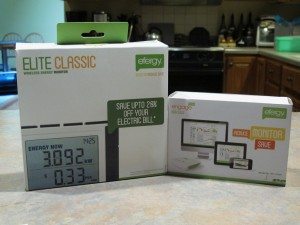


Gadgeteer Comment Policy - Please read before commenting
Holly nuclear reactor batman, what the heck were you running when you were pinging nearly 8kWh..
Electric oven and electric clothes dryer. Use of this device has changed some people’s perception of the amount of power required by our appliances.
Hi Bill,
Great article my friend, your work is a pleasure to read.
My company Eneware is actually an ambassador for the Engage Platform and I am stoked to see it helping people all over the world. Energy Awareness sure has helped plenty of my clients in Australia.
We are passionate about helping people to make validated purchases of energy efficient products to ensure they see the return on investment they deserve. Excellent reviews like yours are great for supporting our vision and the outcomes we are able to achieve with the engage platform.
Keep up the great work mate!
Granted we here in Michigan are having a colder and snowier winter than is typical but I have received my second shocking energy bill so I just ordered the Efergy system. I have an amazing frame of reference: last summer I was in Germany for a few months so everything here was off EXCEPT my refrigerator (forgot to turn it off), all my wall adapters 🙁 and my outdoor lighting (which I should have turned my garage lighting off). I used 7.3kWh, 4.6kWh, and 4.8kWh those three months. So that’s how low it could get…
This winter during the last three months I have hit 30.9kWh, 38.1kWh and 38.6kWh. All my lights at my home are energy saving fluorescent except one back porch light above my steps. Stove is gas. I turned my electric wall heaters down for rooms I’m rarely in to 50ºF (10.0ºC). I have programmable thermostat.
Only thing I can think of is that my furnace uses electricity to power the fan that blows the heat through the house. That fan is almost always on! It may be time (and justified by high bills) to get a new furnace. Will save on gas and electricity.
I hope this meter can help me isolate energy usage. I intend one day to leave the thermostat to a setting as if I was home then one day turn it as much off as I can without letting my pipes freeze to see if it might be my furnace. Or said another way, see if I can determine how much energy my furnace is using.
I cannot figure out what is using up so much electricity! This meter will be great if it can (easily) show me my daily energy usage…maybe even hourly (or sections of the day).
Thanks for your review, it looks straight forward to install and convenient to monitor.
Jason,
Thanks for reading. I think you’ll find the Efergy will help you find where you’re using electricity. I sometimes walk around with my iPad and the Efergy app and turn appliances on/off to see what effect that has. Seems like my biggest culprit is the very old second refrigerator I have in the attached garage. I’ll be dumping that soon.
I received my efergy stuff yesterday evening. I installed it (took me a bit of time because my incoming lines did not have much slack and there were a ton of wires leaving the box in the same area).
I see a strange peak occurring about every 40 minutes up to 2kw. It may be my electric heaters in the additions on my home even though they were set to 50F. Boy,
I notice the impact of every wall wart (particularly my 230W PC brick that I leave on 24/7 and the 130W work PC brick), my back porch light is still incadescent (I would need to change my whole fixture because the fluorescent wont fit under the glass cover. I need to get my computer to properly ‘sleep’ (it crashes on wakeup).
This is a nice tool. I have the desktop monitors as well as the iPhone app and website (I have the shortcut on my iPhone homescreen) that I now watch at work:)
Does somebody know if is it posible to connect the hub to internet through an USB dongle?
Hi,
How do you set the cost per kwh in the engage site?
Thanks 🙂
Tom,
On the Dashboard, go to settings and then select My Settings. Here you can set the tariff price, cost per Kwh.
Thanks Bill. There it only allows me to set a value between 1 and 1001, my cost per kwh is 0.1701
I am missing anything? 😀
Tom,
I show a cents sign at the end of the field. I put in the number 13 for my cost and it seems to come out correct. I would suppose you should put in 17.01. Give that a try.
Thanks very much, feel kinda silly now that I couldnt get what the c is for 🙂
Tom,
You’re welcome. The c is actually a cents icon. I don’t see it used much anymore.
Hi, I have the Efergy Classic connected and working great most of the time. The issue I’m running into is that intermittently, once a day or so, the display is loosing connection to the transmitter. I’m having to push the link button to reconnect. I now have the display within 15 feet of the transmitter and am experiencing the same intermittent connection drop. Any suggestions?
Thanks, Tom
Hi Tom, now that winter is upon us here in Australia I am having the same problem of losing the link between tx and rx early in the morning. The unit worked flawlessly through summer. I can only put it down to the cooler weather, although the unit is supposed to work in temps as low as -5c. and it never gets that cool here. although if I pull the batteries in the tx and replace it links immediately. so perhaps somehow with the cool weather the batteries are losing contact. Efergy haven’t been able to offer any solution 🙁
Hi Paul,
I have the same problem. I lose communication between the tx and rx when I put the tx in cold conditions. Efergy went through a process to try and remove built up static from the tx but the problem cam back within an hour when I placed the tx outside near the meter box. It does not make any sense but the only reason I can put this down to is the drop in temperature. During a sunny day, the tx and rx keep comms.
Tom,
Mine has been working great since the review. The only thing I’ve had to do is replace the batteries once or twice. Give that a try and see what happens.
Fantastic review (even over a year later). Wondering if you really think that the online app is worth it. I’m on the fence about buying a used one.
It’s an extra $80 and I’d love some input. Do you actually use the app/hub a lot?
Hey Chris,
Yes, I still use the whole package. I’ve put the remote display in the kitchen so we can all see it. I have even gotten my wife to be more conscious about turning off burners and the oven, because she can see the usage. I use the use the web application to see when my peak usage times are. I also check the app on my phone once or twice a day, to insure I haven’t left something on when I’m out. This is one of the few products that I’ve used continuously since I reviewed it.
Are these devices compliant with electrical codes? Are they permitted by home insurance policies? I cannot find any information on this.
Ray,
It does not modify any electrical wiring, so I don’t see why there should be any regulatory or insurance issue. It’s less intrusive than plugging in a toaster.
Did you shut the power off (e.g., main disconnect at the meter) before attaching to the cables inside the breaker box panel? Or did you do everything “hot”?
I did everything with the power on. It’s just a matter of clamping the sensors around the incoming mains. If that makes you nervous, you could shut of the power at the meter, if you have a setup like mine. I have a breaker at the meter.
Great post…I have it and love it. One question. What was the voltage you used as your input? Each of my mains tested at 123V. I have 2 clamps as well.
So should I have that as my voltage or 246V since the 2 clamps feed one transmitter? Or does the transmitter figure it out for us.
I think their Euro basis (standard 240V service) has me second guessing.
Thanks again.
Dean,
123 v is correct. That’s the voltage at each leg. I have mine set to 121 v as measured across one leg.
why has two clamps?
one for N
one for L
This is a good review.However, after running my setup now for over a year I had=ve come to the conclusion that, like many good products it suffers from “follow-up”. Once the kit has been sold there is an apparent vacuum when any attempt is made to contact them to ask a quarstion, such as why is there no option to show the difference (solar-home) to show real usage. Why is there not a more flexixible approach to analysing/showing costs such as Fixed costs and multiple tariffs?
In concept, this is a great product. I have the transmitter and receiver installed on my single phase 240V home service and all features appear to function as advertised. However I’ve discovered an issue I have not been able to resolve. When set for 120V (correct, according to instructions) it appears to report too low at all loads. When set at 240V (incorrect, according to the instructions) it is more accurate but reads higher than it should, particularly at higher loads. Oddly, even at the higher voltage setting the unit logs lower energy usage than I’m being billed for. Therein lies my interest in resolving this issue.
I have a spot energy monitor that I’ve used to confirm my microwave’s output at 1840 watts. The Efergy unit set for 120V reports about 8% less. It does worse with my 780-watt toaster, reporting about 18% lower. Although I have no direct means of individually measuring my 240V dryer, the unit is rated for 24A and is being reported by the Efergy at a KW usage equivalent to only about 16A, 34% lower than rated.
As alluded to, the big problem is my inability to reconcile my own energy consumption readings with the local PUD. They installed self-monitoring meters a couple years ago and not long after my household electric bill seemed to be going up. Paranoia, perhaps, but until I get a sensible explanation, I can’t help but feel suspicious about the PUD’s equipment.
Unless I can get sensible readings from my own equipment I have no basis for questioning my electric bills. Assuming nobody can offer any suggestion(s) to remedy the discrepancy in my Efergy’s readings, I’ll have to assume equipment malfunction and see about obtaining replacement(s). I’ll appreciate any helpful input.
To clarify, my home is 120/240 single phase and my Efergy is connected with 2 CT sensors.
D Cardiel
I have exactly the same problem.
ATM, I has 2 separate systems running simultaneously and both are reading low. I have spent all afternoon checking them.
With a base line of approx. 500w when I plug in a 1000w heater they are only reading a 550w increase in power usage. Similarly when I plug in a 2000w heater I only get a 1400w increase in power usage. Both heaters have been checked with a separate meter and are running at 1007w and 1987w so the Effergy units is definitely out.
I will now try adjusting the input voltage to see if I can fudge it to get more accurate readings. But to me it seems that these units are hit and miss as far as accuracy goes. There also does not seem to be any way to calibrate them.
I would suggest if you want accuracy get another product.
A really nice read! Thanks for this elaborate article. Since a lot of time has passed since writing this, there have been advancements in technology that enables you to monitor exact power usage instead of approximate.
I stumbled across a fantastic device a few days ago called Ohm Assistant (https://ohmassistant.com/) which is built on Machine Learning. And because of it, it doesn’t need to install sensors in individual devices to monitor them.
Once it is installed in your home meter and enabled, it empowers you to accurately see the power consumption of your individual devices on your smartphone that too in real-time. I haven’t tried it personally yet but I am planning to subscribe to it soon.